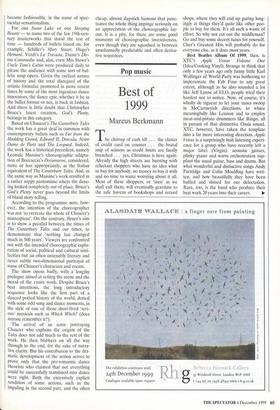Dance
God's Plenty (Sadler's Wells)
Epic return
Giannandrea Poesio
It was in the first half of the 18th century that some dance practitioners started to react against the dramatic emptiness of bal- let performances. They began to experi- ment with a more expressive way of using complicated steps and movement to pro- vide some sort of narrative. By the end of the first half of the same century, the fathers of the ballet d'action, as the reformed theatre art is generally known, engaged in endless and often heated debates on the most effective ways of trans- lating literary, operatic and dramatic works into dance.
Much as I revere those theorists/chore- ographers and their unique contribution to the development of theatre dancing, I often wish they had never done anything of the sort. By demonstrating that anything, or almost anything, was possible, they showed the way to less culturally scrupulous dance- makers who never thought twice about ran- sacking other art fields. Not even the critical remarks expounded by illustrious dance masters, such as Carlo Blasts in one of his many early 19th-century writings on the limits of choreographic composition, prevented the creation of absurd choreo- graphic adaptations. Ballet epics thus
became fashionable, in the name of spec- tacular sensationalism.
For one Swan Lake or one Sleeping Beauty — to name two of the few 19th-cen- tury masterworks that stood the test of time — hundreds of ballets based on, for example, Schiller's Mary Stuart, Hugo's Hernani, Verdi's La Traviata, Dante's Div- ina Commedia and, alas, even Mrs Stowe's Uncle Tom's Cabin were produced daily to please the audience with some sort of bal- letic soap opera. Given the cyclical nature of history and the total disregard of the artistic formulae promoted in more recent times by some of the most ingenious dance innovators, the dance epic, whether it be in the ballet format or not, is back in fashion. And there is little doubt that Christopher Bruce's latest creation, God's Plenty, belongs in this category.
Based on Chaucer's The Canterbury Tales the work has a great deal in common with contemporary ballets such as Far from the Madding Crowd, Edward 11, Dracula, Notre Dame de Paris and The Leopard. Indeed, the work has a historical precedent, namely Leonide Massine's choreographic adapta- tion of Boccaccio's Decameron, considered, more or less appropriately, as the Italian equivalent of The Canterbury Tales. And, in the same way as Massine's work resulted in a rather soppy pantomime where the danc- ing looked completely out of place, Bruce's God's Plenty never goes beyond the limits of bland story-telling.
According to the programme note, how- ever, the intention of the choreographer was not 'to recreate the whole of Chaucer's masterpiece'. On the contrary, Bruce's aim is to show a parallel between the times of The Canterbury Tales and our times, to demonstrate that 'nothing has changed much in 500 years'. Viewers are confronted not with the intended choreographic explo- ration of social, political and cultural simi- larities but an often untenably literary and never subtle two-dimensional portrayal of some of Chaucer's characters and events.
The show opens badly, with a lengthy prologue aimed at setting the scene and the mood of the entire work. Despite Bruce's best intentions, the long introductory sequence looks like the first part of a danced potted history of the world, dotted with some odd song and dance moments, in the style of one of those short-lived 'seri- ous' musicals such as Which Witch? (does anyone remember it?). .
The arrival of an actor portraying Chaucer who explains the origins of the Tales does not add much to the rest of the work. He then blabbers on all the way through to the end, for the sake of narra- tive clarity. But his contribution to the dra- matic development of the action serves to prove only that the pre-romantic dance theorists who claimed that not everything could be successfully translated into dance were right. Both the excessively explicit rendition of some actions, such as the impaling in the second part, and the often cheap, almost slapstick humour that punc- tuates the whole thing impinge seriously on an appreciation of the choreographic lay- out. It is a pity, for there are some good moments of choreographic inventiveness, even though they are squashed in between unashamedly predictable and often deriva- tive sequences.



















































































 Previous page
Previous page